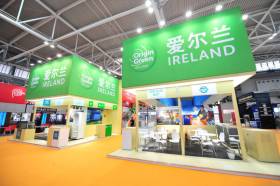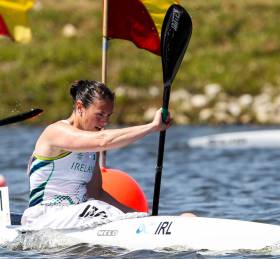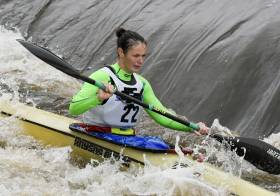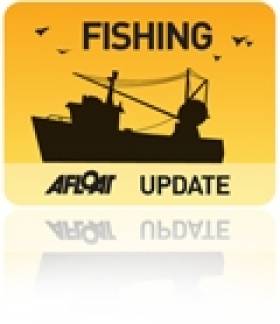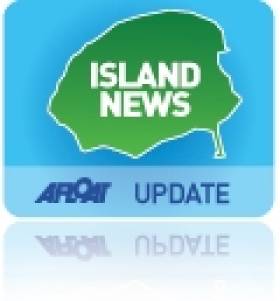Displaying items by tag: China
Dugong Declared Functionally Extinct in China, Researchers Say
Marine wildlife researchers have declared the unique dugong to be functionally extinct in Chinese waters.
BBC News reports on the study conducted by the Zoological Society of London and Chinese Academy of Science, which found that there have been no verified sightings of the aquatic mammal — a close relative of the manatee — for at least 22 years.
The dugong, which is believed to have inspired classic tales of mermaids, was classified as a key protected species in China in 1988 after decades of being hunted close to extinction.
But it’s believed that continued destruction of its inshore habitat — particularly the seagrass that make up the bulk of the vegetarian animal’s diet — has caused a "rapid population collapse”, researchers say.
BBC News has more on the story HERE.
First of Next Generation Stena E-Flexers ‘Floats’ in China
#ferries - It was an important milestone for ferry operator, Stena Line as its major new fleet investment programme involved the ‘launching’ ceremony of the first of its next generation RoPax vessels that took place in China yesterday, 16th January.
The first new vessel will be named Stena Estrid which took to the water for the first time at the Avic Weihai Shipyard. The newbuild is scheduled to enter service on the Dublin to Holyhead route in early 2020 and represents the first of three new E-Flexer vessels bound for Irish Sea routes by 2021.
Stena Line CEO Niclas Mårtensson said: “Today the first of our new generation vessels achieved a very important milestone for Stena Line. The Stena Estrid successfully completed her ‘float out’ manoeuvre from dry dock at the Avic Shipyard and now enters a busy phase of works ahead of her Irish Sea launch early next year.”
All three vessels that are being built for the Irish Sea will be larger than today’s standard RoPax vessels at 215 meters long with a freight capacity of 3,100 lane meters and the space to carry 120 cars and 1,000 passengers. This represents a significant multi-million investment by Stena Line and underscores its commitment to its Irish Sea operations and its determination to deliver the best possible freight and travel experience. Stena Line has a strong belief that Irish Sea ferry transportation will continue to grow and it remains a key strategic business region for the company.
“Stena Estrid will bring many benefits to ferry users including speedy and efficient loading/unloading operations plus further development of our Scandinavian inspired facilities including our restful and bespoke Hygge Lounge and the latest upgrade of our premium product, the Stena Plus concept. The new ships will be spacious, light and make use of panoramic views. This is a very exciting time for our business and I’m proud that as Europe’s largest ferry company, Stena Line continues help shape the industry for the next generation of freight and leisure customers,” concluded Niclas Martensson.
In addition to the three Irish Sea bound E-Flexer vessels, Stena Line has also ordered a further two E-Flexer RoPax vessels with a larger design, to be deployed within Stena Line’s network in 2022. These larger ships will be 240 meters long with a total freight capacity of 3,600 lane meters, and passenger capacity of 1,200. Stena Lines sister company Stena RoRo is managing all the E-Flexer building projects that are ongoing on Avic Weihai Shipyard.
Irish Seafood To Make An Impression At Major Trade Expo In China
Later this week Andrew Doyle, Minister of State at the Department of Agriculture, Food and the Marine, will lead Irish participation in Qingdao, China at the Seafood Expo, one of the largest seafood fairs in the world.
Irish seafood exports to China have grown rapidly to over €28 million last year, and there is potential for further growth. Up to 12 Irish seafood companies will be represented on the Origin Green Ireland stand.
This trade visit follows technical meetings to discuss meat market access held by DAFM officials in Beijing on Friday, and the Trade Mission to Indonesia and Malaysia led by Marine Minister Michael Creed, who also addressed the Our Ocean Conference in Bali last Monday.
“Market development, including understanding, accessing and growing new markets, is a key theme of our shared Food Wise 2025 strategy, and an important response to the challenges posed by Brexit,” Minster Doyle said.
Earlier in the week the minister will attend the CIIE (Chinese Import and Export Expo) in Shanghai. This Chinese government-led expo, to be opened by President Xi Jinping, is intended to serve as a showcase for China’s commitment to international trade.
The Irish delegation will be led by Heather Humphreys, Minister for Business, Enterprise and Innovation and will feature a significant presence from Bord Bia and a total of 11 Irish meat and dairy companies.
Jenny Egan Takes Third World Cup Medal in China
#Canoeing: Ireland's Jenny Egan finished third in the canoe marathon World Cup race over 26.2 kilometres in Shanghai today. This was the final race of the International Canoe Federation series in Shaoxing and Shanghai. Egan took a silver and a bronze in the first and second races. The three medals brings her tally of medals in marathon events this year to six.
Egan Takes Second World Cup Medal in China
#Canoeing: Jenny Egan took bronze at the canoe marathon World Cup in Shanghai in China. Kristina Bedek of Serbia won the 3.6 kilometre K1 race, with Lizzie Broughton of Britain and Egan filling the next two slots in a close finish. Egan had taken silver on Monday at the World Cup in Shaoxing.
Ireland also had another good finish in Shanghai. Barry Watkins took fourth in the men’s race.
Jenny Egan Takes Silver in China World Cup
#Canoeing: Jenny Egan took a silver medal at the ICF Marathon World Cup in Shaoxing, China. Anna Adamova Koziskova of the Czech Republic won a sprint finish with the Ireland athlete at the end of the 26.2 kilometre race. Lizzie Broughton of Britain was third.
This World Cup is new on the international circuit and while the top marathon canoeists have been invited, not all have travelled. Unusually for this discipline, there has been prize money for competitors.
#SeafoodExports - Food and Marine Minister Michael Creed and his Chinese counterpart have agreed an export certificate which will permit the resumption of live crab exports to the critically important Chinese market.
The Irish seafood sector has been extremely anxious to resolve a number of certification issues which have hampered the trade, and exports are expected to resume in the very near future, according to the Department of Agriculture, Food and the Marine (DAFM).
The agreement was one of a number of issues settled between Minister Creed and Zhi Shuping, China’s minister with responsibility for the Chinese Quarantine and Inspection Service, during their meeting in Dublin this week at which they signed a landmark protocol for seafood, beef and thoroughbred horse exports.
The meeting on Tuesday (18 April) was the second formal bilateral meeting of the two ministers and comes after Minister Creed’s discussions with Minister Zhi in Beijing last September.
Commenting on the meeting, Minister Creed said: “China is now such an important partner for Ireland on agri-food issues and is our third largest trading partner in this sector,” said Minister Creed on the meeting, adding that the protocol signing “marks the culmination of intensive political, technical and diplomatic engagement with the Chinese authorities.
“I look forward to moving forward with the next steps as quickly as possible”
Irish agri-food exports to China have increased from some €240 million in 2012 to €780 million in 2016, a three-fold increase. This makes China the third largest market for Ireland’s agri-food sector in value terms after the UK and US for last year.
Hong Kong To Debut As Volvo Ocean Race Stopover Destination
#VOR - Hong Kong will host the Volvo Ocean Race for the first time when the event visits in February 2018 during the 13th edition.
In a press conference today (Wednesday 13 April), VOR organisers announced a unique collaboration with the Hong Kong Sailing Federation to bring the race to Hong Kong’s Victoria Harbour.
It is set to be the largest world-class sailing event ever staged in Hong Kong, already one of the world’s most prestigious sailing destinations.
The world’s premier offshore race will transform the old airport in Kai Tak, and introduce residents of Hong Kong to a wide range of race-related activities geared to educate as well as entertain both existing fans and newcomers to the race.
An in-port race will also be held in the port before the boats leave for the next leg.
Anthony Day, Council Member of the Hong Kong Sailing Federation, said: “This will go down in history as a milestone event for Hong Kong sailing and will provide a wonderful platform for us to engage more Hongkongers in the sport of sailing."
Antonio Bolaños Lopez, acting CEO of the Volvo Ocean Race before Mark Turner takes up the role later this year, added: “I am thrilled that the race is visiting one of the most beautiful ports in the world for the first time.
"We are delighted to welcome Hong Kong to the Volvo Ocean Race family and know that we will have a stopover that will be one of the highlights of the 2017-18 edition.
“I would like to pay special tribute to the Hong Kong Sailing Federation and the Hong Kong government for making our dreams of bringing the race here a reality.”
Hong Kong brings the confirmed list of stopovers so far for the Volvo Ocean Race 2017-18 edition to nine, which includes Alicante, Auckland, Cape Town, Cardiff, Newport in Rhode Island, Lisbon, Gothenburg and The Hague, which will host the finale after a successful pit-stop on the final leg of the 2014-15 race.
The Hong Kong stopover will mark the fourth time the Volvo Ocean Race has visited China, after Qingdao in the 2008-09 race and Sanya in the 2011-12 and 2014-15 competitions.
Coveney Welcomes Record Irish Presence At Chinese Seafood Expo
#Seafood - Following a meeting today (5 November) with Chinese Vice Minister Niu Dun, who has responsibility for fisheries, Marine Minister Simon Coveney opened the largest ever Irish pavilion at the China Seafood & Fisheries Expo, which takes place in Qingdao this week.
Speaking at the event, Minister Coveney said: “Ireland has some of the finest seafood in the world, with a superior offering that is sustainably harvested from the pure, clean waters of the Atlantic Ocean.
"Business development and trade show events such as these are invaluable in building awareness of our high quality produce to an influential, targeted trade audience.
"China continues to be a growing market for Irish seafood and with exports increasing by over 300% since 2011 to reach €18 million in 2013. This strong trend in Irish exports to the region is continuing in 2014 with sales for the first 6 months up 56% compared to the same period last year.”
Organised by Bord Bia, Ireland’s stand will include representatives from a record 11 Irish seafood companies between today and Friday 7 November at the largest trade show in China, with more than 25,000 visitors expected from over 100 countries.
In 2013, China's seafood trade surpassed €20 billion in value, cementing its position as the world's leading seafood trading country. Growing incomes and increased urbanisation have helped fuel a massive growth in demand for imported seafood.
China currently accounts for one quarter of the world’s seafood consumption, and the United Nation’s FAO projects that China will need an extra 16 million tonnes of seafood by 2020 to meet growing demand.
Minister Coveney added: “The strong Irish representation from both the pelagic and shellfish sectors in Qingdao today demonstrates the commitment of both industry and government to deepen ties and strengthen relationships with our Chinese customers.”
Traditionally, the Chinese market has been important for the Irish seafood industry predominantly for the sale of pelagic species such as boarfish, which was launched in China this year after a successful presentation at the 2013 expo.
However, in the last three years, significant effort has been invested by Irish processors and Bord Bia to identify and develop opportunities for premium shellfish in this growing market for seafood, notably for shellfish such as live and processed brown crab, langoustines, scallops and razor fish.
Bord Bia chief executive Aidan Cotter said: “The strong and sustained growth in exports in recent years demonstrates the continued success of Ireland’s leading shellfish processors in penetrating this valuable market. Exports of shellfish to China, for example, increased in value by over 200% between 2012 and 2013, while exports to Hong Kong increased by 117% during the same period.
"Bord Bia has ambitious plans to further grow the share of Irish seafood into China and has a number of programmes in place to assist Irish seafood processors in identifying, profiling and targeting new customers that are willing to pay a premium for quality seafood from Ireland.”
Through its trade development programme, Bord Bia says it has been very successful in encouraging high-end retail and foodservice Chinese customers to visit Ireland to meet with Irish seafood processors on a one-to-one basis.
These itineraries have been described as very effective in generating new business for the sector, providing Irish companies with an excellent opportunity to showcase their processing facilities and also allowing the customers to see first hand the world-class environment in which Irish seafood is produced. These visits can provide a guarantee to Chinese customers on traceability, sustainability and food safety, all key issues of growing concern to the Chinese consumer.
“Irish seafood has enjoyed ongoing and increasing market access to China," said Dr Susan Steel, chair of the Sea-Fisheries Protection Authority. "International trade in food is based upon a reciprocated trust in food safety systems. The Sea-Fisheries Protection Authority, as regulator, verifies the safety and sustainability of Irish seafood and we welcome this Chinese confidence in the robustness of the assurance systems we implement."
During the last three years, Bord Bia has welcomed more than 25 Asian customers to Ireland on customised itineraries. Many of these visits have delivered new business for Irish seafood processors, and in March 2015, as part of its Marketplace International event, Bord Bia will host an additional 17 Asian customers on a visit to Ireland.
The buyers will meet with Ireland’s leading seafood processors, and Bord Bia has set a target of securing €7 million worth of new business for the seafood sector arising from this event.
In September 2013, over €4 million worth of new business was secured with a range of Asian seafood customers who travelled to Ireland to attend Bord Bia’s Global Sustainability Conference.
Going into 2015, to build on the momentum and further increase exports of premium Irish seafood to China, Bord Bia will concentrate its promotional efforts on increasing awareness of new species from Ireland such as brown crab and Irish prawns.
Targeting premium chefs, media and key opinion-formers, Bord Bia will co-ordinate a series of cookery demonstrations in Beijing and Shanghai, focusing on introducing recipes for these species that are new to the Chinese market.
The campaign will assist the Irish processing sector to sell in their ranges to distributors servicing the premium restaurants and hotels in these two key locations. In addition, Chinese consumers will be educated and informed through a comprehensive programme of in-store tastings with a number of supermarket retail chains.
Aran Islanders Represent Ireland In China
#IslandNews - Residents of the Aran Islands are currently in China accompanied by the mayor of Co Galway for a worldwide competition that's doubling as an opportunity to market the West of Ireland as a tourism destination.
The delegation from Inis Oírr are in the southeast coastal city of Xiamen representing Ireland in the 'sustainable communities' category of the Pride of Place competition, according to Galway Bay FM.




























